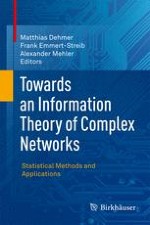2011 | OriginalPaper | Chapter
10. Social Ontologies as Generalized Nearly Acyclic Directed Graphs: A Quantitative Graph Model of Social Tagging
Author : Alexander Mehler
Published in: Towards an Information Theory of Complex Networks
Publisher: Birkhäuser Boston
Activate our intelligent search to find suitable subject content or patents.
Select sections of text to find matching patents with Artificial Intelligence. powered by
Select sections of text to find additional relevant content using AI-assisted search. powered by
